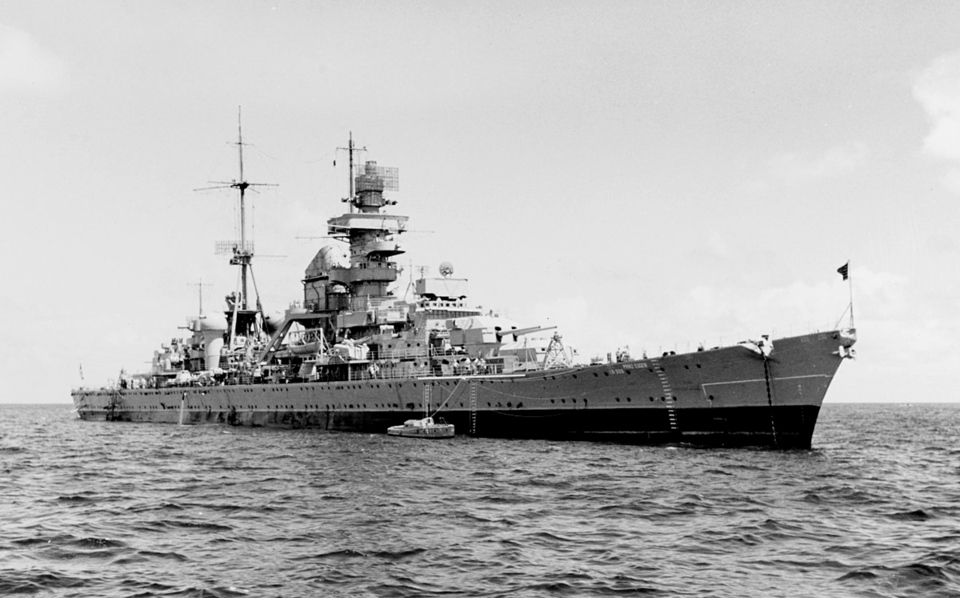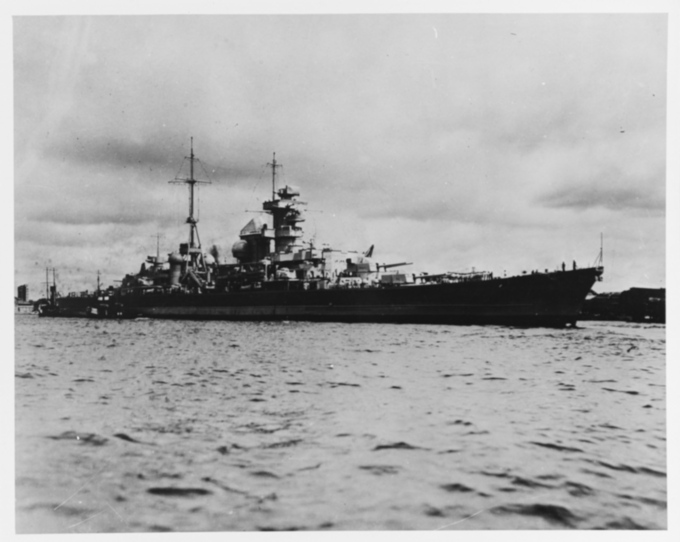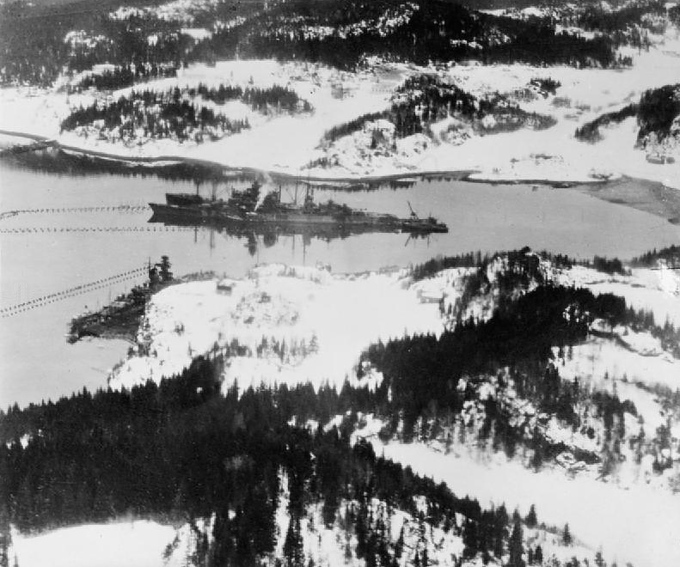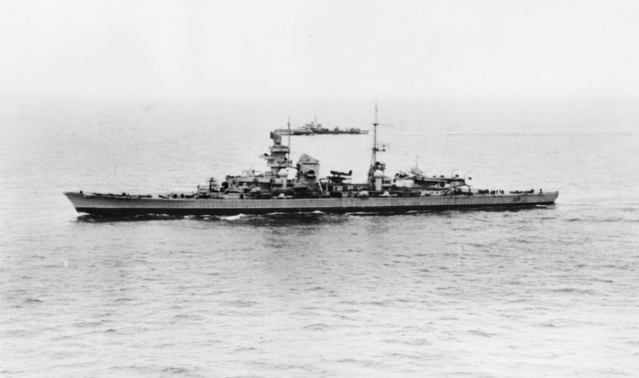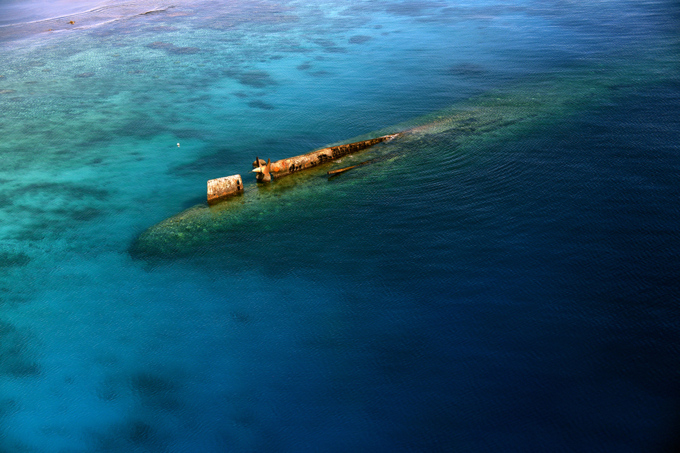The Prinz Eugen was the third and final member of the completed Admiral Hipper-class heavy cruisers. Launched in August 1938, she saw extensive service during WWII, including in the sinking of HMS Hood alongside the Bismarck. Following the cessation of hostilities, she was transferred to the US, where she was used as a test target in the Baker nuclear test. Due to the damage received during the tests, she capsized and sank before repairs could be made.
Design and development
The German Kriegsmarine began to design heavy cruisers in the early 1930s, despite the fact that the Treaty of Versailles banned them from building any ships of the type. Two designs were considered: a heavy cruiser with eight 203 mm (8-inch) guns in four double turrets, and a light cruiser with twelve 152 mm (6-inch) guns in four triple turrets, similar to those found on the Nürnberg. In the end, the heavier option was chosen; however, numerous design improvements resulted in the ship being significantly larger than originally intended.
The final design displaced 14,247 tons and was 205 metres long, larger than the pocket battleship Admiral Graf Spee. Armament was to consist of four dual 203 mm turrets, twelve 105 mm dual-purpose secondary guns and numerous anti-aircraft guns. The ship also carried 22 torpedoes in four triple launchers with ten reloads, as well as three Arado Ar 196 scout planes. The main armour belt was between 70–80 mm in thickness, and armour of up to 160 mm thickness could be found on the conning tower. The ship could reach 32.5 knots (60 km/h) and had a range of 5,050 nautical miles at 15 knots.
The German Kriegsmarine placed orders for a total of five Admiral Hipper-class heavy cruisers, to be known as Admiral Hipper, Blücher, Prinz Eugen, Seydlitz, and Lützow. Of these, the Seydlitz and Lützow would never be completed: Lützow would be sold to the Soviet Union and eventually scrapped, while Seydlitz was scuttled in 1945 after plans to convert her into an aircraft carrier failed. The contract for Prinz Eugen was placed in November 1935. Following three years of construction, the ship was launched in August 1938.
Service life
The Prinz Eugen was fitted out and underwent numerous sea trials, before being formally commissioned on 1st August 1940. The ship then conducted exercises with U-boats and the battleship Bismarck, between September 1940 and April 1941.
On 18th May, the Prinz Eugen accompanied the newly-commissioned Bismarck in Operation Rheinübung, or Exercise Rhine. After arriving in the Denmark Strait, the pair of ships engaged the battleship HMS Prince of Wales and battlecruiser Hood. During the engagement, Prinz Eugen was able to hit Hood once before a shot from Bismarck detonated the battlecruiser’s magazine, resulting in her destruction with the loss of all but three of her crew. After the Hood sank, the Prinz Eugen hit the Prince of Wales three times, without suffering any damage herself.
Due to the Bismarck's damaged state, the two warships broke off soon after the engagement. Prinz Eugen sailed for Brest, where she was repaired. Bismarck was not so lucky, sinking after a long engagement with the battleships HMS Rodney and King George V. While the Prinz Eugen was docked at the Brest shipyard, she was bombed and heavily damaged, losing 60 crew members. Soon after, she participated in the “Channel Dash”, escorting battlecruisers Scharnhorst and Gneisenau through the English Channel towards Kiel. She survived the dash without damage, having fired numerous 203 mm shells at pursuing British destroyers.
In February 1942, the Prinz Eugen departed for Norway with the pocket battleship Admiral Scheer. En route, the submarine HMS Trident scored a torpedo hit on Prinz Eugen's stern. The hit caused severe damage to her stern and rudder, but she was still able to arrive at Trondheim, Norway under her own power. There, she joined Tirpitz and Admiral Scheer to perform attacks on Allied shipping convoys.
In January 1945, as the situation looked dire for Germany, the Prinz Eugen was dispatched to Norway once again, this time to evacuate refugees and provide support. Between 10 March and 4 April 1945, the Prinz Eugen expended almost 5,000 rounds of 203 mm ammunition. She also lost nine men as a result of a Soviet rocket. On 7th May 1945, along with the surrender of mainland German forces, the Prinz Eugen and Nürnberg surrendered in Copenhagen, Denmark.
Nuclear testing
After the surrender, Prinz Eugen was handed to the British. Along with several other German and Japanese prize ships, she was handed over to the United States where she was commissioned as USS Prinz Eugen (IX-300). In early 1946, the Prinz Eugen traversed the Panama Canal and sailed to Bikini Atoll, where she would carry out her final duty as a test vessel in the Operation Crossroads nuclear tests.
On 1st July 1946, the 'Able' nuclear bomb was dropped on an array of vessels, including the Prinz Eugen. The ship, 1.1 km from the epicentre, suffered only minor damage. The second 'Baker' nuclear test also failed to do significant damage. However, the shocks of two nuclear explosions caused leaks to form in the Prinz Eugen's hull, and the ship could not be repaired due to the high levels of radiation. On 22nd December 1946, the Prinz Eugen developed a severe list, and capsized in Kwajalein Atoll. The ship was never salvaged due to the levels of radiation, but one of the ship’s propellers was removed and installed near Kiel as a memorial for those who served in the Second World War.
